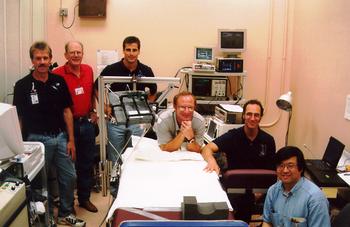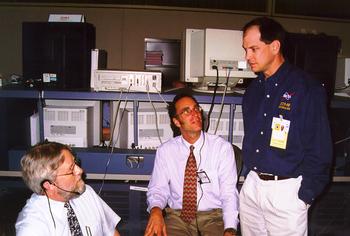Neurolab's return doesn't end VUMC team's mission

On Sunday, VUMC's Andrew Ertl, Ph.D. (second from right), and colleagues from other institutions around the world waited to conduct tests on the shuttle astronauts following Columbia's landing. With Ertl are (from left) Dak Quarles, Dr. Gunnar Blomqvist, Matt Morrow, Dr. Ben Levine and Dr. Satoshi Lwase. (Photo by Andre Diedrich)

At Nuerolab's misson control center in Houston last week, Dr. David Robertson (left) and Andrew Ertl, Ph.D., discussed the mission with alternate payload specialist Alexander Dunlap. (Photo by Andre Diedrich)
Twin sonic booms echoed across the south Florida sky last Sunday to announce the return of the space shuttle Columbia after 16 days in space performing Neurolab experiments.
The day's work, however, was far from over for the NASA astronauts when Columbia rolled to a halt at the Kennedy Space Center at Cape Canaveral.
Immediately, six of the seven crew members were hustled away for further testing by Vanderbilt University Medical Center's Neurolab team.
"It was an incredible sight. We heard two sonic booms and then, there it was," said Andrew C. Ertl, assistant professor of Medicine and a member of VUMC's Neurolab team. "It came in right over us and then touched down. It was an exciting moment.
"Then, we went to work."
VUMC researchers are collecting data to probe the effects of weightlessness on the human nervous system. To better preserve their weightless state the astronauts weren't allowed to stand up once they returned to Earth. According to Ertl, post-flight data will continue to be collected through Saturday, and the information gathered so far is encouraging.
"It's gone extremely well. We are getting good, clear, complete data."
VUMC's team of investigators joined scientists from 25 other universities in seven countries as well as the National Science Foundation, Office of Naval Research, NIH, the space agencies of Canada, Japan, France and Germany, and the European Space Agency to create the experiments conducted on Neurolab. The mission launched on April 17 and returned on Sunday, May 3 after 16 days in space.
Under the direction of Dr. David Robertson, professor of Medicine, director of the Clinical Research Center and co-director of Vanderbilt's Center for Space Physiology and Medicine, the VUMC investigators are part of Neurolab's Autonomic Nervous System Team, which is focusing on blood pressure regulation, gravity and a condition known as orthostatic intolerance.
The VUMC experiments are the most complex human experiments ever to be attempted in space. Two years ago, NASA payload specialists spent two months here training to be able to properly perform the VUMC experiments.
"Those people up there, the astronauts, made history," Ertl said. "In terms of physiological testing conducted on human beings in space, these were the most comprehensive experiments ever attempted, and they went very well."
It's easy to picture the VUMC team's area of interest, orthostatic intolerance: Television images of weak-kneed astronauts struggling to keep their balance following a trip into space. According to Ertl, the majority of astronauts returning to earth are somewhat incapacitated when they attempt to stand. NASA's concern involves the condition's impact on the astronauts' ability to exit the shuttle in the event of an emergency.
Orthostatic intolerance isn't limited only to astronauts returning from space, however. The condition ‹ chronic and sustained periods of dizziness and disorientation ‹ afflicts nearly a half-million people in the United States. Its causes remain a mystery.
VUMC's Neurolab experiment was just one of 26 scientific experiments scheduled to be performed during the mission. The test's three basic components included:
o microneurography, a technique used to measure the electrical activity of sympathetic nerve fibers that control the size of blood vessels;
o norepinephrine spillover, which uses a radioactive isotope tracer to more accurately measure catecholamine levels released in the body during times of stress; and
o lower-body negative pressure testing, which involves a device that draws body fluids downward to simulate, in a micro-gravity environment, the effects of standing up.
The experiments first were performed on earth prior to launch to collect crucial baseline data. They were performed in space by the astronauts and are now being duplicated following the shuttle's return to obtain the most comprehensive information possible, Ertl said.
In a few days the VUMC team and the teams from the other 25 research institutions can begin analyzing the data, reviewing the information collected from an environment that can't be duplicated on earth.
For Robertson, Ertl and the rest of the VUMC team ‹ which includes Dr. Andre Diedrich, visiting scientist from the German Space Agency; Dr. Italo Biaggioni, associate professor of Medicine; Dr. Rose Marie Robertson, professor of Medicine; Lynda D. Lane, senior associate in Medicine; and Sachin Paranjape, research assistant ‹ Neurolab represents the culmination of four years of intense preparation, effort and commitment.
"We have been so focused for so long that it's been hard to sit back and absorb it," Ertl said. "But when you do it's sort of overwhelming, it just wells up inside you.
"We are extremely proud of what the astronauts did up there, and we're also proud of what we were able to do down here."













